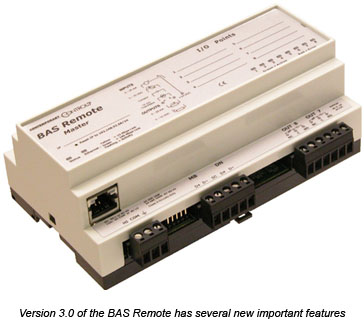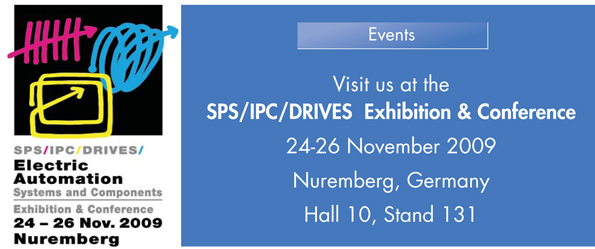Control Network Newsletter

October 2009: Modbus Register Mapping to BACnet® Objects Added to BAS Remote Version 3.0
 Modbus to BACnet mapping has been added to BAS Remote Version 3.0, providing even more functionality to the already versatile building automation appliance. The BAS Remote 3.0 series provides the system integrator with a flexible building block when integrating diverse building automation protocols or when expanding the number of points in a building automation system. By supporting open system protocols such as BACnet, Modbus and Sedona SOX, the BAS Remote's versatility has significantly improved.
Modbus to BACnet mapping has been added to BAS Remote Version 3.0, providing even more functionality to the already versatile building automation appliance. The BAS Remote 3.0 series provides the system integrator with a flexible building block when integrating diverse building automation protocols or when expanding the number of points in a building automation system. By supporting open system protocols such as BACnet, Modbus and Sedona SOX, the BAS Remote's versatility has significantly improved.
 Besides the addition of Powered by Sedona Frameworktm to release 3.0, Contemporary Controls added support for BACnet Change of Value (COV-B), Read Property Multiple (RPM), Foreign Device Registration (FDR), and Modbus register to BACnet object mapping.
Besides the addition of Powered by Sedona Frameworktm to release 3.0, Contemporary Controls added support for BACnet Change of Value (COV-B), Read Property Multiple (RPM), Foreign Device Registration (FDR), and Modbus register to BACnet object mapping.
"The new features added to the BAS Remote have generated universal appeal," said Joe Stasiek, Sales Manager at Contemporary Controls. "Many customers are interested in the BAS Remote's new Modbus mapping capability, which has improved the BAS Remote's ability to integrate different protocols on the same job."
Although BACnet is quite popular, there is an abundance of Modbus Serial equipment that needs to attach to the building automation system. There are two approaches to the problem. The first is to route Modbus Serial messages from the BAS Remote Master MB port to Modbus TCP clients residing on Ethernet. This is the simplest approach requiring minimal configuration. The BAS Remote Master would act as a proxy for a Modbus TCP client, initiating a command to a connected Modbus Serial slave. When the slave responds, the message is forwarded to the Modbus TCP client. The resident BAS Remote Master I/O can be queried in a similar fashion by simply assigning this I/O a non-conflicting Modbus address on the device's web page. The second approach is to utilize the gateway capability within the BAS Remote Master. Using an off-line spreadsheet, Modbus registers and slave addresses are mapped alongside BACnet object instances. The spreadsheet creates a CSV file which is downloaded into the BAS Remote Master for periodic scanning. The result is that attached Modbus Serial devices can be viewed as BACnet objects.
"In addition to the Modbus mapping, function block programming using Sedona Framework means even more open system protocols are supported by the BAS Remote," said Mr. Stasiek.
The BAS Remote Master incorporates Sedona Virtual Machine (SVM) technology developed by Tridium and compatible with their Niagara Framework™. Using established Tridium tools such as Workbench, a system integrator can develop a control application using Workbench's powerful drag-and-drop visual programming methodology. Once developed, the program remains stored in the BAS Remote Master and executes by way of the SVM. The application can run standalone in the BAS Remote Master or interact with a program in a Tridium JACE supervisory controller over Ethernet. The number of potential applications is only limited by the imagination of the system integrator.
"The BAS Remote provides the versatility our customers demand," said George Thomas, president of Contemporary Controls. "The utility device provides additional input/output capability, routing and gateway functionality and now Modbus mapping and logic powered by Sedona Framework. It's a critical building multifunction tool."
More information, including a new 12-page application guide can be found at here.

In This Issue
![]() Feature Story
Feature Story
Modbus Register Mapping to BACnet® Objects Added to BAS Remote Version 3.0
![]() Technology Update
Technology Update
Broadcast Storm Control
![]() EMEA News
EMEA News
Paul French Joins CCL as EMEA Sales Manager
![]() Learn More
Learn More
Free Configuration Tools for Commissioning Modbus to BACnet Mapping
![]() Essentials
Essentials
Introduction to Tridium's Sedona Framework
![]() Control Network
Control Network
View the entire Control Network newsletter as a PDF